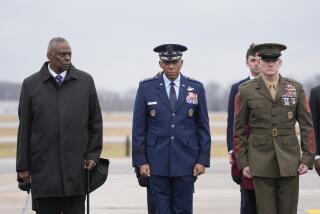CIA drones may be avoiding Pakistani civilians
The CIA passed up a chance last year to kill Sirajuddin Haqqani, the head of an anti-American insurgent network in Pakistan that is closely linked to Al Qaeda and the Afghan Taliban, when it chose not to fire a missile at him from a Predator drone because women and children were nearby, U.S. and Pakistani officials say.
The incident was one of at least three occasions in the last six months when a militant was identified on video and a shot was available, but U.S. officials decided not to fire in order to avoid civilian casualties, said a senior Pakistani official familiar with the drone program.
Killing civilians in drone attacks on insurgents in Pakistan’s tribal regions has generated a powerful anti-American backlash across the country. The anger has been a major public relations problem for both the Obama administration and the government of Pakistani President Asif Ali Zardari, who subscribe to a delicate arrangement under which Pakistani authorities help with intelligence information for the strikes but officially deny involvement.
The Pakistani official, who spoke on condition he not be named, said allowing high-value targets to escape reflected a decision by the U.S. since August to use greater caution in the drone strikes. A strike Aug. 22 destroyed a militant hide-out in North Waziristan, killing 13 members of the Afghan Taliban but also four women and three children who were living among them, according to Pakistani intelligence officials.
The U.S. officials said there had been no policy change and that there always have been occasions when the CIA decided not to fire at a target in the midst of civilians. Those officials would confirm only the Haqqani incident. But they cited two other occasions in the last year when missiles that had already been fired from drones were diverted off target to avoid killing civilians. The officials spoke on condition of anonymity because they were discussing a classified program.
Another factor driving the change, according to a former CIA official, is that the U.S. can afford to forgo an opportunity to kill a senior militant because intelligence and technology improvements to drone operations give the CIA confidence it will get the chance for a clearer shot.
In the past, if the agency passed up an opportunity to strike, the worry was, “Will we ever see that person again. Is this it?” according to the former CIA official. That is less of a concern now, he said.
Members of Congress who received classified briefings on the drone program are satisfied with the efforts made to avoid killing civilians, even if it means passing up opportunities to strike high-value targets, according to congressional sources.
One of the U.S. officials also asserted that no civilian has been killed in more than 75 strikes in Pakistan’s tribal areas since the Aug. 22 strike, suggesting that the CIA, which runs the drone program in Pakistan, has been more judicious in its attacks. And despite a substantial increase in drone strikes in recent months, senior Pakistani officials said complaints about civilian deaths have been scant.
Both the U.S. and Pakistani governments have an interest in getting out a message that they are taking care to avoid civilian deaths. Independent groups that monitor media reports to track U.S. strikes in Pakistan said they cannot confirm the U.S. statistics.
But the New America Foundation, which researches the drone program, estimates that as few as zero and as many as 18 civilians have been killed by U.S. drones since the August hit. Overall, the level of noncombatant deaths dropped from 25% of the total in prior years to an estimated 6% in 2010, according to calculations by the foundation’s Katherine Tiedemann.
The report concerning Sirajuddin Haqqani suggests that sensitivity about civilian casualties has increased. When a CIA missile took out another Taliban leader, Baitullah Mehsud, in 2009, it also reportedly killed his wife and other family members.
Haqqani is a top-priority CIA target who leads an insurgent network that operates in North Waziristan. He is believed to be responsible for cross-border attacks in Afghanistan, and U.S. officials think the Haqqani network helped plan the 2009 suicide bombing at an Afghan base that killed seven CIA officers.
In an April interview, Haqqani admitted planning the January 14, 2008, attack against the Serena Hotel in Kabul that killed six people, including an American citizen. He also admitted to having planned an April 2008 assassination attempt on Afghan President Hamid Karzai. The State Department, which is offering a $5-million reward for information about his location, says he “has coordinated and participated in cross-border attacks against U.S. and coalition forces in Afghanistan.”
The U.S. is required to take steps to avoid killing civilians under the international legal principle of proportionality, but there is no clear standard governing every situation. CIA Director Leon Panetta and his designee have authority to approve the strikes, U.S. officials say.
There have been roughly 180 drone strikes in Pakistan since President Obama took office, more than four times the number that occurred during the eight years of the Bush administration, according to the New America Foundation.
The CIA does not comment on the drone program. U.S. officials say that by the CIA’s count, a total of 30 civilians have been killed since the program was expanded in July 2008, including the wives and children of militants. Officials say that tally is based on video and images of each attack and its aftermath, along with other intelligence.
Independent analysts, while lacking access to the CIA’s data, claim the number is much higher. The New America Foundation estimates that between 277 and 435 noncombatants have died in drone strikes since 2004, out of 1,374 to 2,189 total deaths.
Christopher Rogers, a human rights lawyer who has interviewed relatives of those killed in drone strikes in Pakistan, said he counted 30 civilian casualties after interviewing witnesses to just nine strikes that occurred before August.
U.S. officials contest those numbers, arguing that interviews are not a reliable indicator because relatives of the dead often refuse to acknowledge the suspects were involved with militant groups.
Rogers doubts the U.S. claim of zero noncombatant deaths since August.
“The reality is that all these casualty reports are incredibly dubious,” he said. “It’s not like someone can go out and interview all these people and attest to what happened. The onus is on the United States to make much more of a credible demonstration that the casualties are that low.”
Former CIA officer Bruce Riedel, who was a close advisor to Obama on his Pakistan strategy, said the drone videos don’t always offer a clear picture of casualties. A few Al Qaeda figures believed killed in drone attacks have later turned up alive, he noted.
“Since you can’t be 100% sure about the hard target that you’re trying to kill, I’m not so confident in anyone’s expertise on the soft targets,” said Riedel, author of the just-published “Deadly Embrace: Pakistan, America and the Future of the Global Jihad.” “You can only see so much from 20,000 feet.”
More to Read
Start your day right
Sign up for Essential California for news, features and recommendations from the L.A. Times and beyond in your inbox six days a week.
You may occasionally receive promotional content from the Los Angeles Times.







